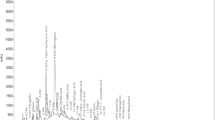Summary
The roles of intermediate conductance Ca2+-activated K+ channel (IKCa1) in the pathogenesis of hepatocellular carcinoma (HCC) were investigated. Immunohistochemistry and Western blotting were used to detect the expression of IKCa1 protein in 50 HCC and 20 para-carcinoma tissue samples. Real-time PCR was used to detect the transcription level of IKCa1 mRNA in 13 HCC and 11 para-carcinoma tissue samples. The MTT assay was used to measure the function of IKCa1 in human HCC cell line HepG2 in vitro. TRAM-34, a specific blocker of IKCa1, was used to intervene with the function of IKCa1. As compared with para-carcinoma tissue, an over-expression of IKCa1 protein was detected in HCC tissue samples (P<0.05). The mRNA expression level of IKCa1 in HCC tissues was 2.17 times higher than that in para-carcinoma tissues. The proliferation of HepG2 cells was suppressed by TRAM-34 (0.5, 1.0, 2.0 and 4.0 μmol/L) in vitro (P<0.05). Our results suggested that IKCa1 may play a role in the proliferation of human HCC, and IKCa1 blockers may represent a potential therapeutic strategy for HCC.
Similar content being viewed by others
References
Parihar AS, Coghlan MJ, Gopalakrishnan M, et al. Effects of intermediate-conductance Ca2+-activated K+ channel modulators on human prostate cancer cell proliferation. Eur J Pharmacol, 2003,471(3):157–164
Jager H, Dreker T, Buck A, et al. Blockage of intermediate-conductance Ca2+-activated K+ channels inhibit human pancreatic cancer cell growth in vitro. Mol Pharmacol, 2004,65(3):630–638
Wang ZH, Shen B, Yao HL, et al. Blockage of intermediate-conductance-Ca(2+)-activated K(+) channels inhibits progression of human endometrial cancer. Oncogene, 2007,26(35):5107–5114
Ouadid-Ahidouch H, Roudbaraki M, Delcourt P, et al. Functional and molecular identification of intermediate-conductance Ca(2+)-activated K(+) channels in breast cancer cells: association with cell cycle progression. Am J Physiol Cell Physiol, 2004,287(1):C125–134
Lallet-Daher H, Roudbaraki M, Bavencoffe A, et al. Intermediate-conductance Ca2+-activated K+ channels (IKCa1) regulate human prostate cancer cell proliferation through a close control of calcium entry. Oncogene, 2009,28(15):1792–1806
Wulff H, Kolski-Andreaco A, Sankaranarayanan A, et al. Modulators of small- and intermediate-conductance calcium-activated potassium channels and their therapeutic indications. Curr Med Chem, 2007,14(13):1437–1457
Barfod ET, Moore AL, Roe MW, et al. Ca2+-activated IK1 channels associate with lipid rafts upon cell swelling and mediate volume recovery. J Biol Chem, 2007,282(12):8984–8993
Wulff H, Miller MJ, Hansel W, et al. Design of a potent and selective inhibitor of the intermediate-conductance Ca2+-activated K+ channel, IKCa1: a potential immunosuppressant. Proc Natl Acad Sci USA, 2000, 97(14):8151–8156
Toyama K, Wulff H, Chandy KG, et al. The intermediate-conductance calcium-activated potassium channel KCa3.1 contributes to atherogenesis in mice and humans. J Clin Invest, 2008,118(9):3025–3037
Wang Z. Roles of K+ channels in regulating tumour cell proliferation and apoptosis. Pflugers Arch, 2004,48(3):274–286
Valverde P, Kawai T, Taubman MA. Potassium channel-blockers as therapeutic agents to interfere with bone resorption of periodontal disease. J Dent Res, 2005,84(6):488–499
El Boustany C, Bidaux G, Enfissi A, et al. Capacitative calcium entry and transient receptor potential canonical 6 expression control human hepatoma cell proliferation. Hepatology, 2008,47(6):2068–2077
Pena TL, Chen SH, Konieczny SF, et al. Ras/MEK/ERK up-regulation of the fibroblast KCa channel FIK is a common mechanism for basic fibroblast growth factor and transforming growth factor-beta suppression of myogenesis. J Biol Chem, 2000,275(18):13677–13682
Grgic I, Eichler I, Heinau P, et al. Selective blockade of the intermediate-conductance Ca2+-activated K+ channel suppresses proliferation of microvascular and macrovascular endothelial cells and angiogenesis in vivo. Arterioscler Thromb Vasc Biol, 2005,25(4):704–709
Minguez B, Tovar V, Chiang D, et al. Pathogenesis of hepatocellular carcinoma and molecular therapies. Curr Opin Gastroenterol, 2009,25(3):186–194
Author information
Authors and Affiliations
Corresponding author
Additional information
This project was supported by grants from the National Natural Science Foundation of China (No. 81072001) and the Natural Science Foundation of Hubei Province, China (No. 2011CDB556).
Rights and permissions
About this article
Cite this article
Yang, Xw., Liu, Jw., Zhang, Rc. et al. Inhibitory effects of blockage of intermediate conductance Ca2+-activated K+ channels on proliferation of hepatocellular carcinoma cells. J. Huazhong Univ. Sci. Technol. [Med. Sci.] 33, 86–89 (2013). https://doi.org/10.1007/s11596-013-1076-0
Received:
Published:
Issue Date:
DOI: https://doi.org/10.1007/s11596-013-1076-0




